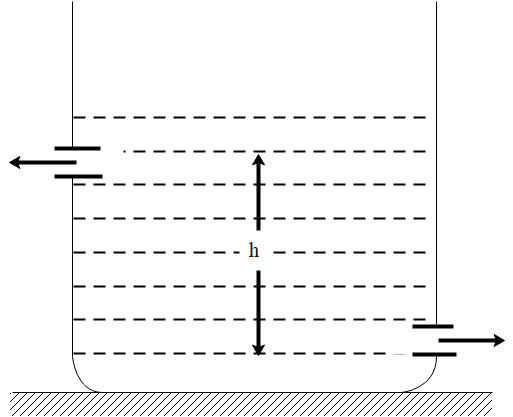
There are two identical small holes of area of cross section a on the opposite sides of a tank containing a liquid of density $ \rho . $ The difference in height between the holes is h. Tank is resting on a smooth horizontal surface. Horizontal force which has to be applied on the tank to keep it in equilibrium is:

(A) $ g h \rho a $
(B) $ \dfrac{2gh}{\rho a} $
(C) $ 2\rho agh $
(D) $ \dfrac{\rho gh}{a} $

Answer
570.3k+ views
Hint
We know that Newton's second law states that a net force acting on an object causes the object to accelerate in the direction of the force. The third law can be understood this way for every action force, there is an equal and opposite reaction force. The net force is the vector sum of all the forces that act upon an object. That is to say, the net is the sum of all the forces, taking into account the fact that a force is a vector and two forces of equal magnitude and opposite direction will cancel each other out.
Complete step by step answer
We know that the net force reaction is:
Where,
$ \text{F}={{\text{F}}_{\text{B}}}-{{\text{F}}_{\text{A}}}=\dfrac{\text{d}{{\rho }_{\text{B}}}}{\text{dt}}-\dfrac{\text{d}{{\rho }_{\text{A}}}}{\text{dt}} $
$ ={{\operatorname{av}}_{\text{B}}}\rho \times {{\text{v}}_{\text{B}}}-{{\operatorname{av}}_{\text{A}}}\rho \times {{\text{v}}_{\text{A}}} $
$ \rho $ is the density, $ v $ is the velocity, $ F $ is force, $ a $ is area, $ h $ is height.
Therefore, we can derive the equation of net force.
$ \therefore \text{F}=\operatorname{ap}\left( \text{v}_{\text{B}}^{2}-\text{v}_{\text{A}}^{2} \right)\ldots \ldots (i) $
According to Bernoulli’s theorem,
$ {{\rho }_{\text{A}}}+\dfrac{1}{2}\rho \text{v}_{\text{A}}^{2}+\text{pgh}={{\rho }_{\text{B}}}+\dfrac{1}{2}\rho \text{v}_{\text{B}}^{2}+0 $
$ \Rightarrow \dfrac{1}{2}\rho \left( \text{v}_{\text{B}}^{2}-\text{v}_{\text{A}}^{2} \right)=\rho \text{gh} $
$ \Rightarrow \text{v}_{\text{B}}^{2}-\text{v}_{\text{A}}^{2}=2\text{gh}\ldots \ldots \text{(ii)} $
From the given equations (i) and (ii), we get the equation,
$ \text{F}=\operatorname{a}\rho (2\text{gh})=2\text{a}\rho \text{gh} $
Therefore, the correct answer is Option (C).
Note
We know that Bernoulli’s theorem states that within a horizontal flow of fluid, points of higher speed will have less pressure than points of slower fluid speed. We can say that the sum of pressure energy, kinetic energy, and potential energy per unit mass of an incompressible, non-viscous fluid in a streamlined flow remains constant. For example, this principle explains why airplane wings are curved along the top and why ships have to steer away from each other as they pass. The pressure above the wing is lower than below it, providing life from underneath the wing.
We know that Newton's second law states that a net force acting on an object causes the object to accelerate in the direction of the force. The third law can be understood this way for every action force, there is an equal and opposite reaction force. The net force is the vector sum of all the forces that act upon an object. That is to say, the net is the sum of all the forces, taking into account the fact that a force is a vector and two forces of equal magnitude and opposite direction will cancel each other out.
Complete step by step answer
We know that the net force reaction is:
Where,
$ \text{F}={{\text{F}}_{\text{B}}}-{{\text{F}}_{\text{A}}}=\dfrac{\text{d}{{\rho }_{\text{B}}}}{\text{dt}}-\dfrac{\text{d}{{\rho }_{\text{A}}}}{\text{dt}} $
$ ={{\operatorname{av}}_{\text{B}}}\rho \times {{\text{v}}_{\text{B}}}-{{\operatorname{av}}_{\text{A}}}\rho \times {{\text{v}}_{\text{A}}} $
$ \rho $ is the density, $ v $ is the velocity, $ F $ is force, $ a $ is area, $ h $ is height.
Therefore, we can derive the equation of net force.
$ \therefore \text{F}=\operatorname{ap}\left( \text{v}_{\text{B}}^{2}-\text{v}_{\text{A}}^{2} \right)\ldots \ldots (i) $
According to Bernoulli’s theorem,
$ {{\rho }_{\text{A}}}+\dfrac{1}{2}\rho \text{v}_{\text{A}}^{2}+\text{pgh}={{\rho }_{\text{B}}}+\dfrac{1}{2}\rho \text{v}_{\text{B}}^{2}+0 $
$ \Rightarrow \dfrac{1}{2}\rho \left( \text{v}_{\text{B}}^{2}-\text{v}_{\text{A}}^{2} \right)=\rho \text{gh} $
$ \Rightarrow \text{v}_{\text{B}}^{2}-\text{v}_{\text{A}}^{2}=2\text{gh}\ldots \ldots \text{(ii)} $
From the given equations (i) and (ii), we get the equation,
$ \text{F}=\operatorname{a}\rho (2\text{gh})=2\text{a}\rho \text{gh} $
Therefore, the correct answer is Option (C).
Note
We know that Bernoulli’s theorem states that within a horizontal flow of fluid, points of higher speed will have less pressure than points of slower fluid speed. We can say that the sum of pressure energy, kinetic energy, and potential energy per unit mass of an incompressible, non-viscous fluid in a streamlined flow remains constant. For example, this principle explains why airplane wings are curved along the top and why ships have to steer away from each other as they pass. The pressure above the wing is lower than below it, providing life from underneath the wing.
Recently Updated Pages
Master Class 11 Economics: Engaging Questions & Answers for Success

Master Class 11 English: Engaging Questions & Answers for Success

Master Class 11 Social Science: Engaging Questions & Answers for Success

Master Class 11 Biology: Engaging Questions & Answers for Success

Class 11 Question and Answer - Your Ultimate Solutions Guide

Master Class 11 Business Studies: Engaging Questions & Answers for Success

Trending doubts
10 examples of friction in our daily life

One Metric ton is equal to kg A 10000 B 1000 C 100 class 11 physics CBSE

Difference Between Prokaryotic Cells and Eukaryotic Cells

1 Quintal is equal to a 110 kg b 10 kg c 100kg d 1000 class 11 physics CBSE

Explain zero factorial class 11 maths CBSE

What is a periderm How does periderm formation take class 11 biology CBSE




